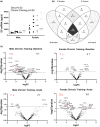Circulating extracellular vesicle characteristics differ between men and women following 12 weeks of concurrent exercise training
- PMID: 38697940
- PMCID: PMC11065700
- DOI: 10.14814/phy2.16016
Circulating extracellular vesicle characteristics differ between men and women following 12 weeks of concurrent exercise training
Abstract
Concurrent resistance and endurance exercise training (CET) has well-studied benefits; however, inherent hormonal and genetic differences alter adaptive responses to exercise between sexes. Extracellular vesicles (EVs) are factors that contribute to adaptive signaling. Our purpose was to test if EV characteristics differ between men and women following CET. 18 young healthy participants underwent 12-weeks of CET. Prior to and following CET, subjects performed an acute bout of heavy resistance exercise (AHRET) consisting of 6 × 10 back squats at 75% 1RM. At rest and following AHRET, EVs were isolated from plasma and characteristics and miRNA contents were analyzed. AHRET elevated EV abundance in trained men only (+51%) and AHRET-induced changes were observed for muscle-derived EVs and microvesicles. There were considerable sex-specific effects of CET on EV miRNAs, highlighted by larger variation following the 12-week program in men compared to women at rest. Pathway analysis based on differentially expressed EV miRNAs predicted that AHRET and 12 weeks of CET in men positively regulates hypertrophy and growth pathways more so than in women. This report highlights sex-based differences in the EV response to resistance and concurrent exercise training and suggests that EVs may be important adaptive signaling factors altered by exercise training.
Keywords: exercise; extracellular vesicles; sex differences.
© 2024 The Authors. Physiological Reports published by Wiley Periodicals LLC on behalf of The Physiological Society and the American Physiological Society.
Conflict of interest statement
No conflicts of interest, financial or otherwise, are declared by the authors.
Figures







Similar articles
-
Functional Role of Extracellular Vesicles in Skeletal Muscle Physiology and Sarcopenia: The Importance of Physical Exercise and Nutrition.Nutrients. 2024 Sep 13;16(18):3097. doi: 10.3390/nu16183097. Nutrients. 2024. PMID: 39339697 Free PMC article. Review.
-
Acute Resistance Exercise Modifies Extracellular Vesicle miRNAs Targeting Anabolic Gene Pathways: A Prospective Cohort Study.Med Sci Sports Exerc. 2024 Jul 1;56(7):1225-1232. doi: 10.1249/MSS.0000000000003408. Epub 2024 Feb 9. Med Sci Sports Exerc. 2024. PMID: 38377006
-
Resistance exercise differentially alters extracellular vesicle size and subpopulation characteristics in healthy men and women: an observational cohort study.Physiol Genomics. 2022 Sep 1;54(9):350-359. doi: 10.1152/physiolgenomics.00171.2021. Epub 2022 Jul 11. Physiol Genomics. 2022. PMID: 35816651
-
Obesity and exercise training alter inflammatory pathway skeletal muscle small extracellular vesicle microRNAs.Exp Physiol. 2022 May;107(5):462-475. doi: 10.1113/EP090062. Epub 2022 Apr 3. Exp Physiol. 2022. PMID: 35293040 Free PMC article.
-
The Effects of Dietary Protein Supplementation on Acute Changes in Muscle Protein Synthesis and Longer-Term Changes in Muscle Mass, Strength, and Aerobic Capacity in Response to Concurrent Resistance and Endurance Exercise in Healthy Adults: A Systematic Review.Sports Med. 2022 Jun;52(6):1295-1328. doi: 10.1007/s40279-021-01620-9. Epub 2022 Feb 3. Sports Med. 2022. PMID: 35113389
Cited by
-
Functional Role of Extracellular Vesicles in Skeletal Muscle Physiology and Sarcopenia: The Importance of Physical Exercise and Nutrition.Nutrients. 2024 Sep 13;16(18):3097. doi: 10.3390/nu16183097. Nutrients. 2024. PMID: 39339697 Free PMC article. Review.
-
Effects of Exercise Type on Muscle Strength and Body Composition in Men and Women: A Systematic Review and Meta-Analysis.Medicina (Kaunas). 2024 Jul 22;60(7):1186. doi: 10.3390/medicina60071186. Medicina (Kaunas). 2024. PMID: 39064615 Free PMC article.
-
Training-induced plasma miR-29a-3p is secreted by skeletal muscle and contributes to metabolic adaptations to resistance exercise in mice.Mol Metab. 2025 Aug;98:102173. doi: 10.1016/j.molmet.2025.102173. Epub 2025 May 23. Mol Metab. 2025. PMID: 40414597 Free PMC article.
-
Exploring the Impact of Exercise-Derived Extracellular Vesicles in Cancer Biology.Biology (Basel). 2024 Sep 6;13(9):701. doi: 10.3390/biology13090701. Biology (Basel). 2024. PMID: 39336127 Free PMC article. Review.
References
-
- Abdelsaid, K. , Sudhahar, V. , Harris, R. A. , Das, A. , Youn, S.‐W. , Liu, Y. , McMenamin, M. , Hou, Y. , Fulton, D. , Hamrick, M. W. , Tang, Y. , Fukai, T. , & Ushio‐Fukai, M. (2022). Exercise improves angiogenic function of circulating exosomes in type 2 diabetes: Role of exosomal SOD3. The FASEB Journal, 36(3), e22177. 10.1096/fj.202101323R - DOI - PMC - PubMed
-
- Annibalini, G. , Contarelli, S. , Lucertini, F. , Guescini, M. , Maggio, S. , Ceccaroli, P. , Gervasi, M. , Ferri Marini, C. , Fardetti, F. , Grassi, E. , Stocchi, V. , Barbieri, E. , & Benelli, P. (2019). Muscle and systemic molecular responses to a single flywheel based iso‐inertial training session in resistance‐trained men. Frontiers in Physiology, 10, 554. 10.3389/fphys.2019.00554 - DOI - PMC - PubMed
-
- Aswad, H. , Forterre, A. , Wiklander, O. P. B. , Vial, G. , Danty‐Berger, E. , Jalabert, A. , Lamazière, A. , Meugnier, E. , Pesenti, S. , Ott, C. , Chikh, K. , El‐Andaloussi, S. , Vidal, H. , Lefai, E. , Rieusset, J. , & Rome, S. (2014). Exosomes participate in the alteration of muscle homeostasis during lipid‐induced insulin resistance in mice. Diabetologia, 57(10), 2155–2164. 10.1007/s00125-014-3337-2 - DOI - PMC - PubMed
-
- Barcellos, N. , Cechinel, L. R. , de Meireles, L. C. F. , Lovatel, G. A. , Bruch, G. E. , Carregal, V. M. , Massensini, A. R. , Dalla Costa, T. , Pereira, L. O. , & Siqueira, I. R. (2020). Effects of exercise modalities on BDNF and IL‐1β content in circulating total extracellular vesicles and particles obtained from aged rats. Experimental Gerontology, 142, 111124. 10.1016/j.exger.2020.111124 - DOI - PubMed
Publication types
MeSH terms
Substances
Grants and funding
LinkOut - more resources
Full Text Sources
Molecular Biology Databases
Miscellaneous

